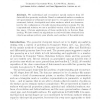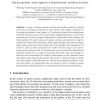84 search results - page 7 / 17 » On the Use of Shape Primitives for Reversible Surface Skelet... |
ECCV
2004
Springer
14 years 9 months ago
2004
Springer
We understand and reconstruct special surfaces from 3D data with line geometry methods. Based on estimated surface normals we use approximation techniques in line space to recogniz...
SIGGRAPH
2000
ACM
13 years 12 months ago
2000
ACM
Surface elements (surfels) are a powerful paradigm to efficiently render complex geometric objects at interactive frame rates. Unlike classical surface discretizations, i.e., tri...
CVPR
2008
IEEE
14 years 9 months ago
2008
IEEE
Many objects have smooth surfaces of a fairly uniform color, thereby exhibiting shading patterns that reveal information about its shape, an important clue to the nature of the ob...
CAIP
2005
Springer
14 years 1 months ago
2005
Springer
In order to achieve precise, accurate and reliable tracking of human movement, a 3D human model that is very similar to the subject is essential. In this paper, we present a new sy...
COMPUTING
2007
13 years 7 months ago
2007
Reverse engineering is concerned with the reconstruction of surfaces from three-dimensional point clouds originating from laser-scanned objects. We present an adaptive surface rec...


